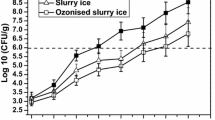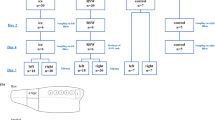Abstract
Slurry ice, a biphasic system consisting of small spherical ice crystals surrounded by seawater at subzero temperature, was evaluated as a new chilled storage method for whole sea bass (Dicentrarchus labrax) a sparidae fish species of remarkable commercial interests. Four different group of chilling methods were used in this study; in slurry ice packaged on board (group A), in slurry ice packaged on company after 2 h (group B), slurry + flake ice packaged on board (group C) and only flake ice packaged on board (group D). The effect of this advanced system at the beginning of storage on quality losses and the shelf-life of aquacultured sea bass was evaluated. Mesophilic counts for sea bass exceeded 7 log cfu/g, which is considered the maximum level for acceptability for freshwater and marine fish after 13 days for groups C and D, and 15 days for groups A and B. At day 15; total volatile basic nitrogen (TVB-N) values of groups A–D reached the legal limits (35 mg/100 g set for TVB-N) for consumption. According to the results of sensory analyses, up to day 11, all the groups were determined as ‘acceptable’ but on day 13, the groups A–D were no longer acceptable. The main negative aspect related to quality loss in slurry ice group corresponded to the appearance of eyes and gills. Using slurry ice at the beginning of packaging did not affect the shelf-life of sea bass stored at 4 °C.


Similar content being viewed by others
References
Rodriguez O, Losada V, Auborg SP, Barros-Velazquez J (2004) Enhanced shelf-life of chilled European hake (Merluccius merluccius) stored in slurry ice as determined by sensory and assessment of microbiological activity. Food Res Int 37:749–757
Anonymus (2004) WA Seafood Quality Management Initiative. The Western Australian Quality Finfish Guide 1–4
Huidobro A, Lopez-Caballero M, Mendes R (2002) Onboard processing of deepwater pink shrimp (Parapenaeus longirostris) with liquid ice: Effect on quality. Eur Food Res Technol 213(4/5):267–272
Huidobro A, Mendes R, Nunes ML (2001) Slaughtering of gilthead seabream (Sparus aurata) in liquid ice: Influence on fish quality. Eur Food Res Technol 213(4/5):267–272
Gregersen F (2001) Storage in ice water increases weight. Fiskeriforskning. Info Norwegian Institute of Fisheries and Aquaculture Ltd. No. 1, pp 1
Body LC, Green DP, LePors LA (1992) Quality changes of pondraised hybrid striped sea bass during chillpack and refrigerated storage. J Food Sci 59–62
Vyncke W (1996) Comparison of the official EC method for the determination of total volatile bases in fish with routine methods. Archiv für Lebensmittelhygiene, 47:110–112
Harrigan WF, McCance ME (1976) Laboratory Methods in Food and Dairy Microbiology. Academic Press Inc.:London
Schubring R (2002) Influence of freezing/thawing and frozen storage on the texture and colour of brown shrimp (Crangon crangon) Archiv für Lebensmittelhygiene 53(2):34–36
Alasalvar C, Taylor KDA, Oksuz A, Garhtwaite T, Alexis MN, Grigorakis K (2001) Freshness assessment of cultured sea bream (Sparus aurata) by chemical, physical and sensory methods. Food Chem. 72:33–40
Hebard CE, Flick GJ, Martin RE (1982) Occurrence and significance of trimethylamine oxide cand its derivatives in fish and shellfish. In: Martin RE, Flick GJ, Hebard CE, Ward DR (eds) Chemistry and Biochemistry of Marine Food Products. Avi: Westport, CO, pp 149–304
Simeonidou S, Govaris A, Vareltzis K (1998) Quality assessment of seven Mediterranean fish during storage on ice. Food Res Int 30(7):479–484
Huss HH (1988) Fresh fish quality and quality changes. FAO Fisheries Series, No. 29, FAO, Rome
Connell JJ (1995) Control of Fish Quality, 4th edn. Fishing News Books Limited, London
Papadopoulos V, Chouliara I, Badeka A, Savvaidis IN, Kontominas MG (2003) Effect of gutting on microbiological, chemical, and sensory properties of aquacultured sea bass (Dicentrarchus labrax) stored in ice. Food Microbiol 20:411–420
Pineiro C, Vazquez J, Perez-Diz A, Gallardo JM, Auborg SP (2003) Chemical changes related to quality loss during farmed turbot chilling by applying flow and traditional icing. In: Proceedings of the First Joint Trans-Atlantic Fisheries Technology Conference, TAFT 2003, 33rd WEFTA and 48th AFTC Meetings, Reykjavik, Iceland, pp 71–72
Rodriguez O, Barros-Velazquez J, Ojea A, Pineiro C, Gallardo JM, Aubourg S (2003) Effect of chilled storage in flow ice on the microbiological quality and shelf life of farmed turbot (Psetta maxima) isolation and identification of major proteolytic bacteria. In: Proceedings of the First Joint Trans-Atlantic Fisheries Technology Conference, TAFT 2003, 33rd WEFTA and 48th AFTC Meetings, Reykjavik, Iceland, pp 73–74
Losada V, Pineiro C, Rodriguez O, Antonia JM, Barros-Velazquez J, Auborg SP (2003) Improvement of horse mackerel (Trachurus trachurus) quality during chilling storage by flow ice application: Assessment of chemical changes. In: Novas Perspectivas sobre conservaçao, processamento e qualidae de alimentos. Ipimar/SPQ, Lisbonne, Portugal, pp 329–333
ICMSF (1978) Microorganisms in Foods, (Vol. 2). The International Commission on Microbiological Specifications for Foods, Toronto, Canada
Dalgaard P (1995) Qualitative and quantitative characterization of spoilage bacteria from packed fish. Int J Food Microbiol 26:319–333
Drosinos EH, Nychas G-JE (1996) Brochothrix thermosphacta, a dominant organism in during the ice storage of fish and shrimp. Food Microbiol 19:617–625
Gram L, Huss H (1996) Microbiological spoilage of fish and fish products. Int J Food Microbiol 33:589–595
Koutsoumanis K, Nychas G-JE (2000) Application of a systematic procedure to develop a microbial model for rapid fish shelf life predictions. Int J Food Microbiol 60:171–184
Kyrana VR, Lougovois VP, Valsamis DS (1997) Assessment of shelf-life of maricultured gilthead sea bream (Sparus aurata) stored in ice. Int J Food Sci Technol32:339–347
Campos CA, Rodriguez O, Losada V, Aubourg SP, Barros-Velazquez J (2004) Effects of storage in ozonized slurry ice on the sensory and microbiological quality of sardine (Sardina pilchardus). In: Proceedings of the WEFTA Conference, 12–15 September
Author information
Authors and Affiliations
Corresponding author
Rights and permissions
About this article
Cite this article
Cakli, S., Kilinc, B., Cadun, A. et al. Effects of using slurry ice on the microbiological, chemical and sensory assessments of aquacultured sea bass (Dicentrarchus labrax) stored at 4 °C. Eur Food Res Technol 222, 130–138 (2006). https://doi.org/10.1007/s00217-005-0117-8
Received:
Revised:
Published:
Issue Date:
DOI: https://doi.org/10.1007/s00217-005-0117-8




